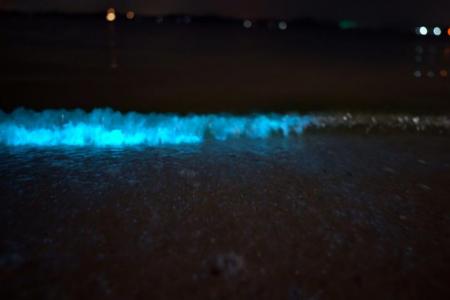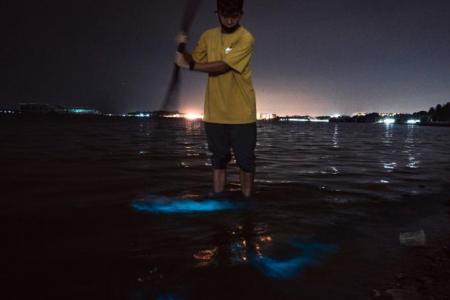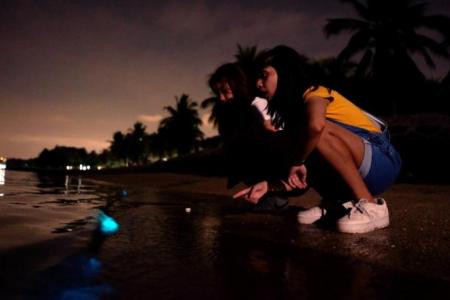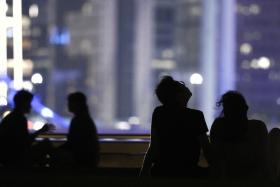Waves light up with algae bloom
Waters around Singapore have been "on fire" in recent days, with blue streaks of light resembling the base of a candle's flame spotted offshore and on waves at beaches in Pasir Ris and Changi.
These sparks were emitted by a group of marine microorganisms called dinoflagellates.
Dr Emily Curren, a marine biologist at the Tropical Marine Science Institute of the National University of Singapore (NUS), said there have been previous sightings of such bioluminescent algal blooms, including along Singapore's southern coastline in 2016.
However, there is no cyclical occurrence of this phenomenon, she said. This means it is hard to predict when these blooms can occur here.
Elsewhere, such bioluminescent algal blooms have made beaches in Maldives and Puerto Rico famous for their spectacles of an ocean that glitters with ghostly blue light.
A bioluminescent bloom also made it into the movie The Beach, which was filmed in Thailand and in which American actor Leonardo DiCaprio starred.
Mr Eric Teo, a first-year student at Nanyang Technological University's Wee Kim Wee School of Communications, was at Pasir Ris Park on Sunday morning (March 20) filming a movie when he made the serendipitous discovery of the glittery algal bloom.
One scene involved actors running along the shoreline, and as they were doing so, the water turned a brilliant neon blue.
Mr Teo, 24, told The Straits Times: "We brushed it off initially as we thought they were light reflections from the moon or lamp posts. But as we went closer, we noticed blue glitter-like particles in the water whenever it crashed on the shore."
On Tuesday, Mr Teo shared videos of the bioluminescent waves on a Facebook Group, Nature Society (Singapore), which has been shared around 4,500 times.
When ST visited Pasir Ris Beach on Tuesday (March 22) night, the waters also lit up with blue sparks when disturbed by splashing.
Dr Curren said these dinoflagellates are already present in Singapore's waters.
"Due to suitable climatic conditions such as temperature, salinity and rainfall, they will reproduce rapidly and form algal blooms, leading to the bioluminescent sighting when the cells are being disturbed and pushed together by waves for example," she said.
The bioluminescent algal blooms have also been spotted at Changi and East Coast Park, and offshore.
Mr Sirius Ng, a marine biology PhD student from the department of biological sciences at NUS, said he caught sight of the blue glow while sampling water for plankton in waters off Changi.
He said: "To my knowledge, we haven't seen this extent of bioluminescence in recent years. However, I do know a friend who saw this phenomenon when he was a child in the 80s."
Freelance nature guide Inez Alsagoff, 23, also spotted the blue waves at Changi Beach on Sunday while having a barbecue with friends.
Ms Alsagoff said: "The waves that crashed produced a slightly blue glow, but we knew about glowing phytoplankton because we are all environmental studies students and we learnt about it before."
Armed with the knowledge that they could make the light brighter by agitating the water, they kicked up the waves, which led to the sight of underwater, brilliant, blue light.
"We didn't know that we could experience the blue tide in Singapore and it was a totally unexpected encounter," she said. "We'll be going back this weekend to check it out and hopefully it's still there."
Asked how long this phenomenon would last, Dr Curren said it depends on how long water conditions remain favourable for the algae to proliferate.
She added: "Usually for dinoflagellates , warm water and a stable water column would promote their blooms."
A stable water column usually means that there is little mixing of the different "layers", with warmer, less dense water sitting atop cooler, denser water.
However, Dr Curren said some of these dinoflagellate species may not be well studied. For instance, it is not known which species of dinoflagellate caused the 2016 bloom.
Dr Curren said: "We humans can enjoy this natural phenomenon by just looking and taking photos from afar. The best way is to avoid direct contact if we do not understand them and their characteristics."
Get The New Paper on your phone with the free TNP app. Download from the Apple App Store or Google Play Store now




